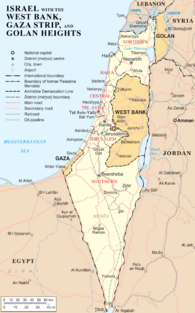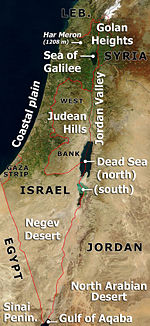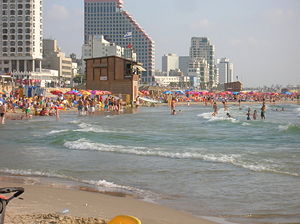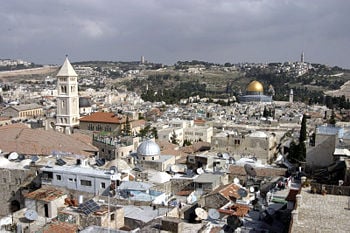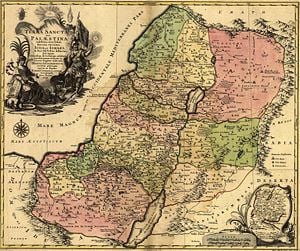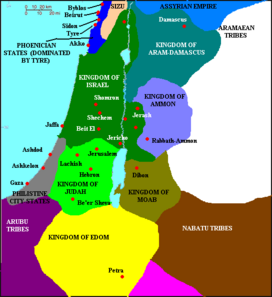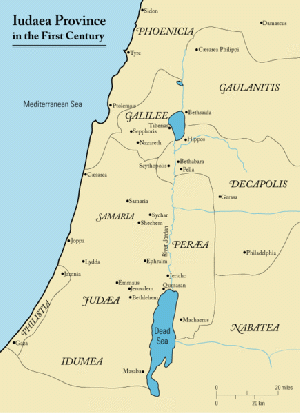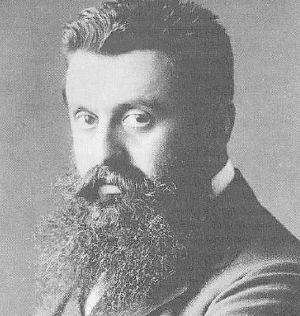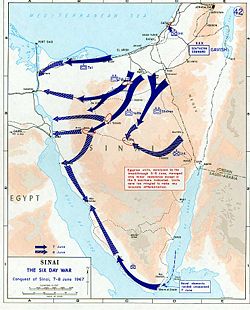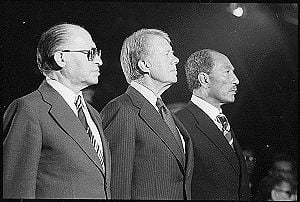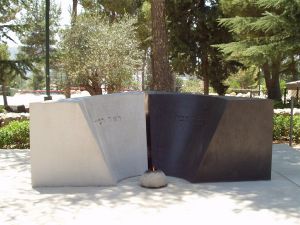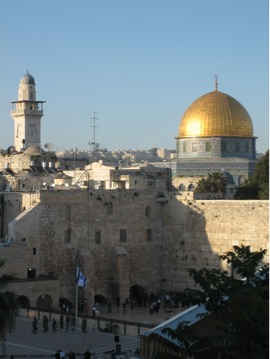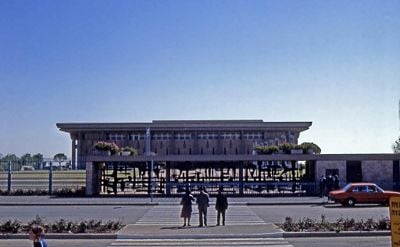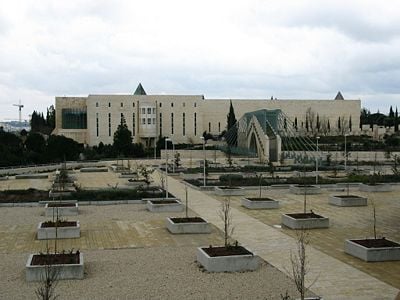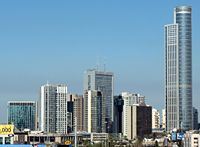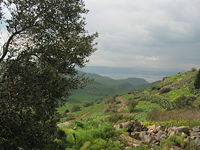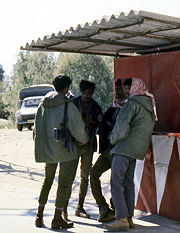Difference between revisions of "Israel" - New World Encyclopedia
Mike Butler (talk | contribs) m |
Mike Butler (talk | contribs) m |
||
| Line 271: | Line 271: | ||
==Economy== | ==Economy== | ||
| − | [[Image:Bursa05.jpg|thumb| | + | [[Image:Bursa05.jpg|thumb|200px|A main business district in [[Gush Dan]] where the diamond stock exchange is located.]] |
| − | Israel is the most industrially and economically developed country in the [[Middle East]]. It has a technologically advanced market economy with substantial government participation. It depends on imports of fossil fuels (crude oil, natural gas, and coal), grains, beef, raw materials, and military equipment. Despite limited natural resources, Israel has intensively developed its agricultural and industrial sectors over the past 20 years. Israel is largely self-sufficient in food production except for grains and beef. Diamonds, high technology, military equipment, software, pharmaceuticals, fine chemicals, and agricultural products (fruits, vegetables and flowers) are leading exports. Israel usually posts sizable current account deficits, which are covered by large transfer payments from abroad and by foreign loans (although some economists would say the deficit is a sign of Israel's advancing markets). Israel possesses extensive facilities for oil refining, diamond polishing, and semiconductor fabrication. According to international data reported by the World Bank, Israel has the best regulations for businesses and strongest protections of property rights in the Greater Middle East. | + | Israel is the most industrially and economically developed country in the [[Middle East]]. Israel's economy was originally based on a socialist model, in which the Histadrut trade union controlled agriculture, industry, and health care. However, Histadrut's power has been weakened as the country has adopted more capitalist policies. |
| + | |||
| + | It has a technologically advanced market economy with substantial government participation. It depends on imports of fossil fuels (crude oil, natural gas, and coal), grains, beef, raw materials, and military equipment. Despite limited natural resources, Israel has intensively developed its agricultural and industrial sectors over the past 20 years. Israel is largely self-sufficient in food production except for grains and beef. Diamonds, high technology, military equipment, software, pharmaceuticals, fine chemicals, and agricultural products (fruits, vegetables and flowers) are leading exports. Israel usually posts sizable current account deficits, which are covered by large transfer payments from abroad and by foreign loans (although some economists would say the deficit is a sign of Israel's advancing markets). Israel possesses extensive facilities for oil refining, diamond polishing, and semiconductor fabrication. According to international data reported by the World Bank, Israel has the best regulations for businesses and strongest protections of property rights in the Greater Middle East. | ||
Roughly half of the government's external debt is owed to the [[United States]], which is its major source of economic and military aid. A relatively large fraction of Israel's external debt is held by individual investors, via the Israel Bonds program. The combination of American loan guarantees and direct sales to individual investors, allow the state to borrow at competitive and sometimes below-market rates. | Roughly half of the government's external debt is owed to the [[United States]], which is its major source of economic and military aid. A relatively large fraction of Israel's external debt is held by individual investors, via the Israel Bonds program. The combination of American loan guarantees and direct sales to individual investors, allow the state to borrow at competitive and sometimes below-market rates. | ||
| Line 280: | Line 282: | ||
Twenty-four percent of Israel's workforce holds university degrees, ranking Israel third in the industrialized world after the United States and [[Netherlands]]. Twelve percent hold advanced degrees. | Twenty-four percent of Israel's workforce holds university degrees, ranking Israel third in the industrialized world after the United States and [[Netherlands]]. Twelve percent hold advanced degrees. | ||
| − | + | Some land is privately owned and some is public property. Israel has a system of kibbutzim — cooperative farms in which property is collectively owned. Residents share chores, and receive housing, medical care, and education instead of wages. There are moshav farming communities in which each family owns a house and is responsible for an area of land, while products are sold collectively. | |
===Science and technology=== | ===Science and technology=== | ||
Revision as of 23:13, 10 May 2007
Template:Infobox Israel
The State of Israel (Hebrew: מְדִינַת יִשְׂרָאֵל ▶, Medinat Yisra'el; Arabic: دَوْلَةْ إِسْرَائِيل, Dawlat Isrā'īl) is a country in the Western Asian Levant, on the southeastern edge of the Mediterranean Sea.
Israel declared its independence in 1948. With a diverse population currently exceeding seven million citizens of primarily Jewish background and religion, it is the world's only Jewish state.
Jerusalem is the capital city and seat of government. The national President's residence, government offices, supreme court and parliament are located in Jerusalem, which is Israel's capital according to Israel's Basic Law. This states that "Jerusalem, complete and united, is the capital of Israel." However, the Palestinian Authority sees East Jerusalem as the future capital of Palestine. Also, the United Nations and most countries do not accept the Basic Law, arguing that Jerusalem's final status must await future negotiations between Israel and the Palestinian Authority. Most countries maintain their embassies in Tel Aviv
Israel is the only country in the Middle East considered to be a liberal democracy, having a broad array of political rights and civil liberties present. In addition, Israel is considered the most advanced in the region in terms of freedom of the press, commercial law, economic competition, and overall human development.
The land of Israel holds a special place in Jewish religious obligations, encompassing Judaism's most important sites (such as the remains of the First and Second Temples of the Jewish People).
Geography
The name "Israel" is rooted in the Hebrew Bible, Genesis 32:28, where Jacob is renamed Israel after successfully wrestling with an angel of God. The biblical nation fathered by Jacob was then called "The Children of Israel" or the "Israelites". The modern country was named State of Israel, and its citizens are referred to as Israelis in English. Other rejected name proposals included Eretz Israel, Zion, Judea and New Judea.
Israel is bordered by Lebanon in the north, Syria and Jordan in the east, and Egypt in the south-west. It has coastlines on the Mediterranean Sea in the west and the Gulf of Eilat (also known as the Gulf of Aqaba) in the south.
During the Six-Day War of 1967, Israel captured the West Bank from Jordan, the Golan Heights from Syria, Gaza Strip (which was under Egyptian occupation), and Sinai Peninsula from Egypt. It withdrew from Sinai by 1982 and from the Gaza Strip by September 12, 2005. The future status of the West Bank and the Gaza Strip remains to be determined. East Jerusalem has been under Israeli civil law, jurisdiction and administration since and the Golan Heights since 1981, though they have not been formally annexed.
The sovereign territory of Israel, excluding all territories captured by Israel in 1967, is 8019 square miles (20,770 square kilometres) in area (one percent is water), or slightly smaller than New Jersey in the United States.
Israel is divided east-west by a mountain range running north to south along the coast. Jerusalem sits on the top of this ridge, east of which lies the Dead Sea graben (an elongated, relatively depressed crustal unit bounded by faults on both sides).
The numerous limestone and sandstone layers of the Israeli mountains allow the water to pour from the west flank to the east. Several springs have formed along the Dead Sea, each an oasis, most notably the oasis' at Ein Gedi and Ein Bokek where settlements have now developed.
Israel also has a number of large limestone karsts. These caves are around comfortable 20°C warm, although only one is open to the public. Very common all around the country are small natural caves and abris. These have been used for thousands of years historically as shelter, housing, storage rooms, barns and churches.
Israel is divided into four main geographical regions: the Israeli Coastal Plain, the central hills, the Jordan Rift Valley, and the Negev Desert.
The Coastal Plain stretches from the Lebanese border in the north to Gaza in the south, interrupted only by Cape Carmel at Haifa Bay. It is about 40 kilometers wide at Gaza and narrows toward the north to about five kilometers at the Lebanese border. The region is fertile and humid] (historically malarial) and is known for its citrus and viniculture. The plain is traversed by several short streams.
East of the coastal plain lies the central highland region. In the north of this region lie the mountains and hills of Galilee; farther to the south are the Samarian Hills with numerous small, fertile valleys; and south of Jerusalem are the mainly barren hills of Judea. The central highlands average 2000 feet (610 meters) in height and reach their highest elevation at Har Meron, at 3963 feet (1208 meters) in Galilee near Safed.
East of the central highlands lies the Jordan Rift Valley, which is a small part of the 4040 mile (6500-kilometer)-long Great Rift Valley. In Israel the Rift Valley is dominated by the Jordan River, the Sea of Galilee (an important freshwater source also known as Lake Tiberias and to Israelis as Lake Kinneret), and the Dead Sea.
The Jordan River, Israel's largest river 200 miles (322 km), originates in the Anti-Lebanon Mountains and flows south through the drained Hulah Valley into the freshwater Lake Tiberias. With a water capacity estimated at 106 billion cubic feet (three cubic kilometres), it serves as the principal reservoir for Israel. The Jordan River continues from the southern end of Lake Tiberias (forming the boundary between the West Bank and Jordan) to the highly saline Dead Sea, which is 393 square miles (1020 square kilometres) in size and, at 1309 feet (399 meters) below sea level, is the lowest point in the world.
The Negev Desert comprises approximately 4600 square miles (12,000 square kilometres) more than half of Israel's total land area. Geographically it is an extension of the Sinai Desert, forming a rough triangle with its base in the north near Beersheba, the Dead Sea, and the southern Judean Mountains, and it has its apex in the southern tip of the country at Eilat. Topographically, it parallels the other regions of the country, with lowlands in the west, hills in the central portion, and the Nahal HaArava as its eastern border.
The climate of the coastal areas can be very different from that of the mountainous areas, particularly during the winter months. The northern mountains can get cold, wet and often snowy and even Jerusalem experiences snow every couple of years. The coastal regions, where Tel Aviv and Haifa are located, have a typical Mediterranean climate with cool, rainy winters and hot, dry summers. January is the coldest month with average temperatures ranging from 43°F to 59°F (6°C to 15°C) ,and July and August are the hottest months at 72°F to 91°F (22°C to 33°C) on average across the state. In Eilat, the desert city, summer daytime-temperatures are often the highest in the state, at times reaching 111°F to 115°F (44°C to 46°C). More than 70 percent of the average rainfall in Israel falls between November and March. The areas of the country most cultivated are those that receive more than 12 inches (300 millimeters) of rainfall annually; about one-third of the country is cultivable.
Natural hazards include sandstorms during spring and summer, droughts, and periodic earthquakes. Thunderstorms and hail are common throughout the rainy season and waterspouts occasionally hit the Mediterranean coast, capable of causing only minor damage. However, supercell thunderstorms and a true F2 tornado hit the Western Galilee April 4, 2006, causing significant damage and 75 injuries.
Regarding environmental issues, limited arable land and natural fresh water resources pose serious constraints, while the nation must deal with on-going problems of desertification, air pollution from industrial and vehicle emissions, groundwater pollution from industrial and domestic waste, and toxic residue from chemical fertilizers, and pesticides.
The capital city is Jerusalem with a population of 719,900, although the metropolitan area of Jerusalem has a total population of 2,300,000, including 700,000 Jews and 1,600,000 Arabs. There are three other metropolitan areas: Tel Aviv (population 3,040,400), Haifa (population 996,000) and Beersheba (population 531,600).
History
Mousterian Neanderthals appear as the earliest human inhabitants , dating from about 200,000 B.C.E. The first anatomically-modern humans in the area were called the Kebarans, conventionally dated from 18,000 B.C.E. to 10,500 B.C.E. but may have arrived as early as 75,000 B.C.E. They were followed by the Natufian culture (c. 10,500 B.C.E. - 8500 B.C.E.), the Yarmukians (c. 8500 B.C.E. - 4300 B.C.E.) and the Ghassulians (carbon dated c. 4300 B.C.E. - 3300 B.C.E.). The Ghassulian economy consisted of extensive cultivation of grains (wheat and barley), intensive horticulture of vegetable crops, commercial production of vines and olives, and a combination of transhumance and nomadic pastoralism. This culture was probably associated with the first appearance of Semitic languages in this area. At this time, people may have begun living in small city-states, one of which was Jericho. The area's location at the center of three trade routes linking three continents made it the meeting place for religious and cultural influences from Egypt, Syria, Mesopotamia, and Asia Minor:
The beginning of Israel
Sources for the ancient history of Israel include the Hebrew Bible (known to Christianity as the Old Testament), the Talmud, the Ethiopian Kebra Nagast, the writings of Nicolaus of Damascus, Artapanus of Alexandria, Philo of Alexandria and Josephus supplemented by ancient sources uncovered by archeology including Egyptian, Moabite, Assyrian, Babylonian as well as Israelite and Judean inscriptions.
Jewish tradition holds that the Land of Israel has been a Jewish Holy Land and Promised land for four thousand years, since the time of the patriarchs (Abraham, Isaac, and Jacob). The Book of Genesis traces the beginning of Israel to three patriarchs of the Jewish and neighbouring people, Abraham, Isaac and Jacob, the latter also known as Israel from which the name of the land was subsequently derived. Jacob, called a "wandering Aramaean" (Deuteronomy 26:5), the grandson of Abraham, had travelled back to Harran, the home of his ancestors, to obtain a wife. Whilst returning from Haran to Canaan, crossed the Jabbok, a tributary on the Arabian side of the Jordan River (Genesis 32:22-33). Having sent his family and servants away, that night he wrestled with a strange man at a place henceforth called Peniel, who in the morning asked him his name. As a result, he was renamed "Israel", because he has "wrestled with God". and became in time the father of 12 sons, by Leah and Rachel (daughters of Laban), and their maidservants Bilhah and Zilpah. The 12 were considered the "Children of Israel." These stories of the origins of Israel locate it on the east bank of the Jordan. The stories of Israel move to the west bank with the story of the sacking of Shechem (Genesis 34:1-33), after which the hill area of Canaan is assumed to have been the core of the area of Israel. The likely date for these events is in dispute, although some theories place them somewhere between 2000 B.C.E. and 1600 B.C.E.
Exodus
The Biblical book of Genesis relates how some of the descendents of Israel became Egyptian slaves. Some Bible commentaries place the birth of Moses around 1300 B.C.E. The Exodus of the Israelites from Egypt, led by Moses, and its chronology are much-debated. Some believe that the Exodus took place in the reign of Ramesses II (1279 B.C.E. to 1213 B.C.E.) due to the named Egyptian cities in Exodus: Pithom and Rameses. Evidence for an Israelite presence in Palestine has been found from only six years after the end of the reign of Rameses II, in the Merneptah Stele, documenting military campaigns in Canaan.
Exodus goes on to say that after leaving Egypt, nearly three million Israelites wandering in the desert for a generation, the Israelites invaded the land of Canaan, destroying major Canaanite cities such as Ai, Jericho and Hazor. If Ramses II was Exodus Pharaoh, the conquest of Canaan and the destruction of Jericho and other Canaanite cities would have occurred around 1200 B.C.E., despite the fact that Jericho was unoccupied at this time, having been destroyed at about 1550 B.C.E.
Period of the Judges
Around 1200 B.C.E., the Philistines, Tjekker and possibly Danites settled along the cost from Gaza in the south to Joppa in the north, and the entire Middle East fell into a "Dark Age" from which it took centuries to recover". In their initial attacks under Joshua, the Hebrews occupied most of Canaan, which they settled according to traditional family lines derived from the sons of Jacob and Joseph (the "tribes" of Israel). No formal government existed and ad hoc leaders, or the "judges" of the biblical Book of Judges, led in times of crisis. Around 1140 B.C.E., the Canaanite tribes tried to destroy the Israelite tribes of northern and central Canaan, but were defeated.
United Kingdom
Wealth returned to the region with the end of the Late Bronze Age collapse, the period extending between the collapse of the Mycenaean kingdoms, the Hittite Empire in Anatolia and Syria and the Egyptian Empire in Syria and Palestine between 1206 and 1150 B.C.E., down to the rise of settled Aramaean kingdoms of the mid tenth century B.C.E., and the rise of the Neo-Assyrian Empire. Trade with Egypt and Mesopotamia recovered, so a new interior trade route opened up. This new route threatened the trade monopoly of the Philistines, resulting in friction with the tribes of Israel. Increasing pressure from the Philistines, and other neighboring tribes forced the Israelites to unite under one king around 1050 B.C.E. Samuel, one of the last of the judges, anointed Saul ben Kish from the tribe of Benjamin as king.
Upon the death of Saul, David, who killed the Philistine giant Goliath, is made king. David's first action as king of Israel was to conquer Jerusalem and declare it the capital of his kingdom. According to Jewish tradition, Mount Moriah is an important place where Abraham bound Isaac and thus the Temple was to be built there. David conquered Jerusalem in approximately 1004 B.C.E., he brought the Ark of the Covenant to the city, and made the city a center of his government. Jerusalem became the political and spiritual nexus of the Jewish people. King David was instructed not to build the Temple, leaving the task to his son Solomon. The concentration of religious ritual at the Temple made Jerusalem a place of pilgrimage and an important commercial center.
King Solomon, who was born in Jerusalem about 1000 B.C.E. and reigned over Israel from about 970 to 928 B.C.E., was the third and final king of the United Monarchy. Solomon's Temple, also known as the First Temple, was the first Jewish Temple in Jerusalem. Completed in the tenth century B.C.E., it functioned as a religious focal point for worship and the sacrifices known as the korbanot in ancient Judaism. This united kingdom lasted until around 920 B.C.E. when it split into the Kingdom of Israel in the north, and the Kingdom of Judah in the South.
Divided kingdoms
Around 920 B.C.E., Jeroboam led a revolt of the northern tribes, and established the Kingdom of Israel. Economically the state of Israel seems to have been more developed than its southern neighbour. Rainfall in this area is higher and the agricultural systems more productive. According to the Biblical account, there were 19 separate rulers of Israel, although it seems much less politically stable than Judah, maintaining a form of charismatic leadership by merit and competition between ruling families seem to have depended much more on links with outside powers, Tyre, Aram and Assyria, to maintain their authority. Israel was invaded by Egyptian Pharaoh Sheshonk I (the Biblical Shishak), of the Libyan 22nd Dynasty. The kingdom of Israel appears to have been most powerful in the first half of the ninth century B.C.E., during which time, Omri (a. 885-874 B.C.E.) founded a new dynasty with its capital city at Samaria, with support from the Phoenician city of Tyre. Omri's son and successor, supposedly linked through dynastic marriage with Tyre, contributed 2000 chariots, and 10,000 soldiers to a coalition of states which fought and defeated Shalmaneser III at Qarqar in 853 B.C.E. Twelve years later, Jehu, with assistance from the kingdom of Aram, centred in Damascus, organised a coup in which Ahab and his family were put to death. Jehu is shown kneeling to the Assyrian monarch in the black obelisk of Shalmaneser III, the only monarch of either of the two states for which any portrait survives.
Israel, like its southern neighbour fell within the influence of Damascus, and it was to put an end to this domination from its two northern neighbours that Judah appealed to Tiglath Pileser III for Assyrian intervention, which ultimately, in 720 B.C.E. led to the fall of Israel to the Assyrians, under Sargon, and the incorporation of Israel into the Assyrian empire. Despite the attempt by Assyrians to decapitate the Israelite kingdom by settling people on its eastern frontier with the Medes, archaeological evidence shows that many people fled south at this time to Judah, whose capital city Jerusalem seems to have grown by over 500 percent at this time.
The major problems in the history of the divided monarchy is that the Septuagint, the Hebrew Masoretic text, and Josephus all have different figures, it is unknown if the two kingdoms used the same calendar, and it is unclear whether the number of years reigned refer only to full years, part years, or from new year to new year.
In 920 B.C.E. the southern Kingdom of Judah had Jerusalem as its capital and was led by Rehoboam, leading to war with Israel, which according to the Bible, continued during the reigns of Abijiah and Asa of Judah, during whose reign Israel penetrated to Ramah, five kilometers north of Jerusalem. The Dynasty of Omri brought an end to the war with Judah, and cemented a dynastic alliance through Queen Athiliah, daugher of Ahab and Jezebel of Tyre. Judah fell to the Babylonians in 587 B.C.E. The First Temple was destroyed in 586 B.C.E., and the people were taken into captivity.
Captivity
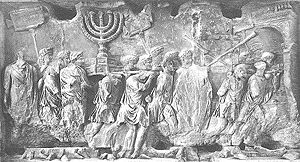
In 722 B.C.E., the Assyrians, under Shalmaneser III, and then under Sargon II, conquered Israel (the northern Kingdom), destroyed its capital Samaria, and sent many of the Israelites into exile and captivity. The ruling class of the northern kingdom (perhaps a small portion of the overall population) were deported to other lands in the Assyrian empire and a new nobility was imported by the Assyrians.
Inhabitants of Judah faced captivity at the hands of the Babylonians under Nebuchadnezzar II in 597 B.C.E., when the Temple of Jerusalem was partly despoiled and a number of the leading citizens were removed. In 586 B.C.E., in the reign of Zedekiah) a fresh rising of the Judaeans occurred, and the city was razed to the ground and a further deportation ensued. Finally, five years later (581 B.C.E.), Jeremiah records a third captivity. After the overthrow of Babylonia by the Persian Empire, Cyrus the Great gave the Jews permission to return to their native land (in 537 B.C.E.), and more than 40,000 are said to have returned.
The Second Temple
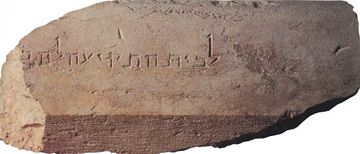
Jews were allowed to return with the Temple vessels that the Babylonians had taken. Under the spiritual leadership of the Prophets Haggai and Zechariah, the Second Temple was completed. At this time the Holy Land is a sub-district of a Persian satrapy (province). From 444 B.C.E., the Jewish scribes Nehemiah and Ezra led a reformation of Israel, instituting synagogue and prayer services. Ezra read the Torah publicly to the Great Assembly that he set up in Jerusalem. Ezra and Nehemiah flourished around this era. This was the Classical period of Ancient Greece). The 'Second Temple stood between 516 B.C.E. and 70 C.E. In 428 B.C.E., Samaritans build their temple on Mount Gerizim
Alexander the Great
Alexander the Great defeated the Persian Empire in 331 B.C.E. The Empire of Alexander the Great included Israel, although he did not attack Jerusalem directly, after a delegation of Jews met him and assured him of their loyalty by showing him certain prophecies contained in their writings. After Alexander’s death in 323 B.C.E., a power struggle ensued, the part of his empire that included Israel changed hands at least five times in just over 20 years. Babylonia and Syria were ruled by the Seleucids, and Egypt by the Ptolemies.
Hasmonean Kingdom
The Hasmonean Kingdom (140 B.C.E.–37 B.C.E.), was an autonomous Jewish state in ancient Israel. The Hasmonean dynasty was established under the leadership of Simon Maccabaeus, two decades after his brother Judas Maccabeus defeated the Seleucid army during the Maccabee Revolt in 165 B.C.E., a victory that Jews still celebrate in the festival of Hanukkah. The Kingdom was the only independent Jewish state to exist in the four centuries after the Kingdom of Judah was destroyed by Babylonia in 586 B.C.E., and was one of the last prior to the modern state of Israel]]. Judah became an independent state in 141 B.C.E. Herod conquered Judah in 37 B.C.E. In 19 B.C.E., under his rule, the Temple was rebuilt. Israel became a client kingdom of the Roman Empire under the Herodian Dynasty.
Roman occupation
Rome's involvement in the area dated from 63 B.C.E., following the end of the Third Mithridatic War, when Rome made a province of Syria. After the defeat of Mithridates VI of Pontus, general Pompeius Magnus (Pompey the Great) remained there to secure the area. Subsequently, during the first century B.C.E., Judea's Hasmonean Kingdom became a client kingdom and then a province of the Roman Empire.
Around 40-39 B.C.E., Herod the Great was appointed King of the Jews by the Roman Senate. Around 4 B.C.E., Jesus and John the Baptist are born. While Pontius Pilate was governor Iudaea (26-36 C.E.), John the Baptist was beheaded and Jesus was crucified. Herod Agrippa I, appointed "King of the Jews" by Claudius, ruled from 41-44 C.E., and Herod Agrippa II, who ruled from 48-100 C.E., was the seventh and last of the Herodians.
Iudaea Province was the stage of three major rebellions , including the Great Jewish Revolt (66-70 C.E.) the Kitos War (115-117 C.E.), and Bar Kokhba's revolt (132-135 C.E.), after which Hadrian changed the name of the province to Syria Palaestina and Jerusalem to Aelia Capitolina in an attempt to erase the historical ties of the Jewish people to the region. In order to worsen the humiliation of the defeated Jews, the Latin name Palaestina was chosen for the area, after the Philistines, whom the Romans identified as the worst enemies of the Jews in history. From then on the region was known as Palestine.
Jewish presence continues
Nevertheless, the Jewish presence in Palestine remained constant. The main Jewish population shifted from the Judea region to the Galilee. The Mishnah and Jerusalem Talmud, two of Judaism's most important religious texts, were composed in the region during this period. The land was conquered from the Byzantine Empire in 638 CE during the initial Muslim conquests. The Hebrew niqqud was invented in Tiberias during this time. The area was ruled by the Omayyads, then by the Abbasids, Crusaders, the Kharezmians and Mongols, before becoming part of the empire of the Mamluks (1260–1516) and the Ottoman Empire in 1517.
Jews living in the Jewish diaspora have emigrated to Israel throughout the centuries. For example, in 1141 Yehuda Halevi issued a call to the Jews to emigrate to Eretz Israel and eventually died in Jerusalem. In 1267, Nahmanides settled in Jerusalem, and since then a continual Jewish presence in Jerusalem has been maintained. Yosef Karo immigrated to the large Jewish community in Safed in 1535. Small waves of immigration occurred during the eighteenth century out of religious motives, famously Menachem Mendel of Vitebsk and 300 of his followers, Judah he-Hasid and over 1000 disciples, and over five hundred disciples (and their families) of the Vilna Gaon known as Perushim. Waves of rabbinical students immigrated in 1808–1809, settling in Tiberias, Safed and then in Jerusalem. In 1860, the old Jewish community in Jerusalem started building neighborhoods outside the walls of the Old City (the first one being Mishkenot Sha’ananim). In 1878, the first modern agricultural settlement was founded in the form of Petah Tikva.
The first big wave of modern immigration to Israel, or Aliyah started in 1881 as Jews fled growing persecution, or followed the Socialist Zionist ideas of Moses Hess and others of "redemption of the soil." Jews bought land from individual Arab landholders. After Jews established agricultural settlements, tensions erupted between the Jews and Arabs.
Zionism
Theodor Herzl (1860–1904), an Austro-Hungarian Jew, founded the Zionist movement. In 1896, he published Der Judenstaat (The Jewish State), in which he called for the establishment of a national Jewish state. The following year he helped convene the first World Zionist Congress. The establishment of Zionism led to the Second Aliyah (1904–1914) with the influx of around 40,000 Jews. In 1917, the British Foreign Secretary Arthur J. Balfour issued the Balfour Declaration that "view[ed] with favour the establishment in Palestine of a national home for the Jewish people." In 1920, Palestine became a League of Nations mandate administered by Britain. Jewish immigration resumed in the |third (1919–1923)]] and fourth (1924–1929)]] waves after World War I. In a massacre in 1929, 133 Jews, including 67 in Hebron were killed and 116 Arabs were killed in riots.
The rise of Nazism in 1933 led to a Fifth Aliyah (1929-1939). The subsequent Holocaust in Europe led to additional immigration from other parts of Europe. The Jewish population in the region increased from 83,790 (11 percent) in 1922 to 608,230 (33 percent) in 1945.
In 1939, the British introduced a white paper, which limited Jewish immigration over the course of the war to 75,000 and restricted purchase of land by Jews, perhaps in response to the 1936-1939 Arab revolt in Palestine. Many Jews fleeing to Palestine to avoid Nazi persecution were intercepted and returned to Europe. Two specific examples of this policy involved the ships Struma and Exodus (carrying Holocaust survivors in 1947). Attempts by Jews to circumvent the blockade and flee Europe became known as Aliyah Bet.
Jewish underground groups
Many Arabs, opposed to the Balfour Declaration, the mandate, and the Jewish National Home, instigated riots and pogroms against Jews in Jerusalem, Hebron, Jaffa, and Haifa. As a result of attacks in 1921, the Haganah was formed to protect Jewish settlements. Several Haganah members formed the militant group Irgun (initially known as Hagana Bet) in 1931. Irgun attacked the British military headquarters, the King David Hotel, which killed 91 people. A further split occurred when Avraham Stern left the Irgun to form Lehi, (also known as the Stern Gang) which was much more extreme, refused any co-operation with the British during World War II, and tried to work with the Germans to secure European Jewry's escape to Palestine.
Partition

In 1947, following increasing levels of Arab-Jewish violence and general war-weariness, the British government decided to withdraw from the Palestine Mandate. The United Nations General Assembly approved the 1947 UN Partition Plan dividing the territory into two states, with the Jewish area consisting of roughly 55 percent of the land, and the Arab area consisting of roughly 45 percent. Jerusalem was to be designated as an international region administered by the UN to avoid conflict over its status.
Immediately following the adoption of the Partition Plan by the UN General Assembly on November 29, 1947, David Ben-Gurion tentatively accepted the partition, while the Arab League rejected it. The Arab Higher Committee immediately ordered a violent three-day strike, attacking buildings, shops, and neighborhoods, and prompting insurgency organized by underground Jewish militias like the Lehi and Irgun. These attacks soon turned into widespread fighting between Arabs and Jews, this civil war being the first "phase" of the 1948 War of Independence.
The State of Israel was proclaimed on May 14, 1948, one day before the expiry of the British Mandate of Palestine. Israel was admitted as a member of the United Nations on May 11, 1949.
1948 war of independence
Over the next few days, approximately 1000 Lebanese, 5000 Syrian, 5000 Iraqi, and 10,000 Egyptian troops invaded the newly-established state. Four thousand Transjordanian troops invaded the Corpus separatum region encompassing Jerusalem and its environs, as well as areas designated as part of the Arab state by the UN partition plan. Volunteers from Saudi Arabia, Libya and Yemen helped. Israeli forces fought back, and captured significant amounts of territory that had been designated for the Arab state of Transjordan, as well as part of Jerusalem.
After numerous months of war, a ceasefire was declared and temporary borders, known as the Green Line, were instituted. Israel had gained an additional 23.5 percent of the Mandate territory west of the Jordan River. Jordan held the large mountainous areas of Judea and Samaria, which became known as the West Bank. Egypt took control of a small strip of land along the coast, which became known as the Gaza Strip.
Large numbers of the Arab population fled or were expelled from the newly-created Jewish State during the Palestinian exodus, which is referred to by many Palestinian groups and individuals as the Nakba, meaning "disaster" or "cataclysm". Estimates of the final Palestinian refugee count range from 400,000 to 900,000 with the official United Nations count at 711,000. The unresolved conflict between Israel and the Arab world that persists has resulted in a lasting displacement of Palestinian refugees. In addition, the entire Jewish population of the West Bank and Gaza Strip also fled to Israel. Within a year of 1948 war, immigration of Jewish refugees from Arab lands doubled Israel's population. Over the following years approximately 850,000 Sephardi and Mizrahi Jews fled or were expelled from surrounding Arab countries. Of these, about 600,000 settled in Israel; the remainder went to Europe and the Americas.
Suez crisis
Between 1954 and 1955, under Moshe Sharett as prime minister, the Lavon Affair—a failed attempt to bomb targets in Egypt—caused political disgrace in Israel. Compounding this, in 1956, Egypt nationalized the Suez Canal, much to the chagrin of the United Kingdom and France. Israel, fearing Egypt's increase in power, staged an attack in the Sinai Desert. Several days later, Britain and France joined the offensive. The United Nations sent peacekeepers, who stayed in the region until 1967.
In 1961, the Nazi war criminal Adolf Eichmann, who had been largely responsible for the Final Solution, the planned extermination of the Jews of Europe, was captured in Buenos Aires, Argentina, by Mossad agents and brought to trial in Israel. Eichmann became the only person ever sentenced to death by the Israeli courts.
The Six-Day War
Tensions arose between Israel and her neighbors in May 1967. Syria, Jordan, and Egypt had been hinting at war and Egypt expelled UN Peacekeeping Forces from the Gaza Strip. When Egypt closed the strategic Straits of Tiran to Israeli vessels, and began massing large numbers of tanks and aircraft on Israel's borders, Israel deemed it a reason for pre-emptively attacking Egypt on June 5. In the ensuing Six-Day War between Israel and its Arab neighbors, Israel defeated the armies of three large Arab states and won a decisive victory over their air forces. Israel conquered the West Bank, Gaza Strip, Sinai Peninsula, and Golan Heights. The Green Line of 1949 became the administrative boundary between Israel and the Occupied Territories. The Sinai was later returned to Egypt following the signing of a peace treaty.
During the war, Israeli aircraft attacked the USS Liberty, killing 34 American servicemen. American and Israeli investigations into the incident concluded that the attack was a tragic accident involving confusion over the identity of the USS Liberty.
In 1969, Golda Meir, Israel's first (and, to 2007, only) female prime minister was elected.
Munich massacre
Between 1968 and 1972, numerous scuffles erupted along the border between Israel and Syria and Egypt. Palestinian groups embarked on an unprecedented wave of attacks against Israel and Jewish targets in other countries. At the 1972 Munich Olympic Games, Palestinian militants held hostage and killed members of the Israeli delegation. Agents of Israel’s Mossad assassinated most of those who were involved in the massacre.
On October 6, 1973, the day of the Jewish Yom Kippur fast, the Egyptian and Syrian armies launched a surprise attack against Israel. Despite early successes against an unprepared Israeli army, Egypt and Syria were eventually repelled. A number of years of relative calm ensued, which fostered the environment in which Israel and Egypt could make peace.
A turning point in Israeli political history came in the 1977 Knesset elections, when the Alignment (political party), which together with its predecessor Mapai had been the ruling party since 1948, was beaten by Menachem Begin's Likud, an event that became known in Israel as the "revolution".
Camp David Accords
In November of that year, Egyptian President Anwar Sadat, making a historic visit to the Jewish State, spoke before the Knesset — the first recognition of Israel by its Arab neighbors. Military reserves officers formed the Peace Now movement to encourage this effort. Following the visit, the two nations conducted negotiations which led to the signing of the Camp David Accords. In March 1979, Begin and Sadat signed the Israel-Egypt Peace Treaty in Washington, DC. As laid out in the treaty, Israel withdrew from the Sinai Peninsula and evacuated the settlements established there during the 1970s. It was also agreed to lend autonomy to Palestinians across the Green Line.
Lebanon invaded
On July 7, 1981, the Israeli Air Force bombed the Iraqi nuclear reactor at Osiraq in an attempt to foil Iraqi efforts at producing an atomic bomb. This operation was known as Operation Opera.
In 1982, Israel launched an attack against Lebanon, which had been embroiled in the civil war since 1975. The reason Israel gave for the attack was to defend Israel's northernmost settlements from terrorist attacks, which had been occurring frequently. After establishing a 40km barrier zone, the Israel Defense Forces continued north and captured the capital, Beirut. Israeli forces expelled Palestinian Liberation Organization forces from the country, forcing the organization to relocate to Tunis. Unable to deal with the stress of the ongoing war, Prime Minister Menachem Begin resigned from his post in 1983 and was replaced by Yitzhak Shamir. Though Israel withdrew from most of Lebanon in 1986, a buffer zone was maintained until May 2000 when Israel unilaterally withdrew from Lebanon.
Gulf War
During the Gulf War, Iraq hit Israel with 39 Scud missiles, although Israel was not a member of the anti-Iraq coalition and was not involved in the fighting. The missiles did not kill Israeli citizens directly, but there were some deaths from incorrect use of the gas masks provided against chemical attack, one Israeli died from a heart attack following a hit, and one Israeli died from a Patriot missile hit. During the war, Israel also provided gas masks for the Palestinians in the West Bank and Gaza. The PLO, however, supported Saddam Hussein. Palestinians in the West Bank and Gaza marched and famously stood on their rooftops while Scud missiles were falling and cheered Hussein, calling for him to bomb Israel with chemical weapons. Palestinians also used the gas masks against Israeli tear gas in the coming years.
A Palestinian uprising called the Intifadah began in 1987. Palestinians threw rocks at Israeli soldiers occupying the Gaza Strip and the West Bank. Israelis retaliated, and the violence escalated, resulting in hundreds of deaths. Israel proposed a peace initiative in 1989. This same year saw the beginning of a mass immigration by Soviet Jews.
Oslo Accords
Yitzhak Rabin elected prime minister in 1992, signed the Oslo Accords with the Palestine Liberation Organization in 1993. In 1994, Jordan made peace with Israel. The initial wide public support for the Oslo Accords began to wane as Israel was struck by an unprecedented wave of attacks supported by the militant Hamas group, which opposed the accords.
On November 4, 1995, a Jewish nationalist militant named Yigal Amir assassinated Rabin. Likud’s Benjamin Netanyahu, elected prime minister in 1996, withdrew from Hebron and signed the Wye River Memorandum, giving wider control to the Palestinian National Authority. During Netanyahu's tenure, Israel experienced a lull in attacks by Palestinian groups, but his government fell in 1999 to Ehud Barak of One Israel.
Arafat rejects offer
Barak initiated unilateral withdrawal from Lebanon in 2000. This process was intended to frustrate Hezbollah attacks on Israel by forcing them to cross Israel's border. Barak and Yassir Arafat once again conducted negotiations with U.S. President Bill Clinton at the July 2000 Camp David summit. However, the talks failed. Barak offered to form a Palestinian State initially on 73 percent of the West Bank and 100 percent of the Gaza Strip. In 10 to 25 years, the West Bank area would expand to 90 percent (94 percent excluding greater Jerusalem). Arafat rejected this deal.
After the collapse of the talks, Palestinians began a second uprising, known as the Al-Aqsa Intifadah, just after the leader of the opposition Ariel Sharon visited the Temple Mount in Jerusalem. The failure of the talks and the outbreak of a new war caused many Israelis on both the right and the left to turn away from Barak, and also discredited the peace movement.
Ariel Sharon was elected prime minister in March 2001, and was subsequently re-elected, along with his Likud party in the 2003 elections. Sharon initiated a plan to unilaterally withdraw from the Gaza Strip. This disengagement was executed between August and September of 2005.
West bank barrier
Israel is building the Israeli West Bank Barrier with the stated purpose of defending the country from attacks by armed Palestinian groups. Because the barrier, which is planned to measure 681 kilometers, meanders past the Green Line, effectively annexes 9.5 percent of the West Bank, and creates hardships for Palestinians living near it. The international community and the Israeli far-left have criticised the wall, but it has significantly reduced the number of terrorist attacks against Israel.
After Ariel Sharon suffered a severe hemorrhagic stroke, the powers of the office were passed to Ehud Olmert, who was designated the "Acting" Prime Minister. On April 14, 2006, Olmert was elected Prime Minister after his party, Kadima, Hebrew for "Forward", won the most seats in the 2006 elections.
On June 28, 2006, Hamas militants dug a tunnel under the border from the Gaza Strip and attacked an Israel Defense Forces post, capturing an Israeli soldier and killing two others. In response, Israel began Operation Summer Rains, which consisted of heavy bombardment of Hamas targets as well as bridges, roads, and the only power station in Gaza. Israel has also deployed troops into the territory. Israel’s critics have accused it of disproportionate use of force and collective punishment of innocent civilians and not giving diplomacy a chance. Israel argues that they have no other option to get their soldier back and put an end to the rocket attacks into Israel, although the soldiers were not recovered.
Clash with Hezbollah
A conflict between Palestinian militant group Hezbollah and Israel began July 12, 2006, with a cross-border Hezbollah raid and shelling, which resulted in the capture of two and killing of eight Israeli soldiers. Israel held the Lebanese government responsible for the attack, as it was carried out from Lebanese territory, and initiated an air and naval blockade, airstrikes across much of the country, and ground incursions into southern Lebanon. Hezbollah continuously launched rocket attacks into northern Israel and engaged the Israeli Army on the ground with hit-and-run guerrilla attacks. A ceasefire came into effect on August 14, 2006, although violations of the ceasefire have occurred from both sides. The conflict killed over one thousand Lebanese civilians, 440 Hezbollah militants, and 119 Israeli soldiers, as well as 44 Israeli civilians, and caused massive damage to the civilian infrastructure and cities of Lebanon and damaged thousands of buildings across northern Israel, many of which were destroyed.
Government and politics
Israel is a democratic republic with universal suffrage that operates under a parliamentary system.
The President of Israel is Head of State, serving as a largely ceremonial figurehead. The president selects the leader of the majority party or ruling coalition in the Knesset as the prime minister]], who serves as head of government and leads the Cabinet. For a short period in the 1990s, the Prime Minister was directly elected. This change was not viewed a success and was abandoned. The 2007 president was Moshe Katsav, though the acting president was Dalia Itzik; the prime minister was Ehud Olmert.
Israel's unicameral]] legislative branch is a 120-member parliament known as the Knesset. Membership in the Knesset is allocated to parties based on their proportion of the vote, via a proportional representation voting system. Elections to the Knesset are normally held every four years, but the Knesset can decide to dissolve itself ahead of time by a simple majority, known as a vote of no confidence. Twelve parties held seats in 2007.
Israel's judiciary is made of a three-tier system of courts. At the lowest level are magistrate courts, situated in most cities. Above them are district courts, serving both as appellate courts and as courts of first instance, situated in Jerusalem, Tel Aviv, Haifa, Be'er Sheva and Nazareth.
At the top of the judicial pyramid is the Supreme Court of Israel seated in Jerusalem. The Supreme Court serves a dual role as the highest court of appeals and as the body for a separate institution known as the High Court of Justice. This court has the unique responsibility of addressing petitions presented by individual citizens. The respondents to these petitions are usually governmental agencies.
A committee composed of Knesset members, Supreme Court Justices, and Israeli Bar members carries out the election of judges. The Courts Law requires judges to retire at the age of 70. The Chief Justice of the Supreme Court, with the approval of the Minister of Justice, appoints registrars to all courts.
Israel is not a member of the International Criminal Court as it fears it could lead to prosecution of Israeli settlers in the disputed territories.
Legal system
Israel has not completed a written constitution. Its government functions according to the laws of the Knesset, including the "Basic Laws of Israel", of which there are presently 14. These are slated to become the foundation of a future official constitution. In mid-2003, the Knesset's Constitution, Law, and Justice Committee began drafting an official constitution.
Israel's legal system mixes influences from Anglo-American, continental and Jewish law, as well as the declaration of the State of Israel. As in Anglo-American law, the Israeli legal system is based on the principle of precedent, it is an adversarial system, not an inquisitorial one, in the sense that the parties (for example, plaintiff and defendant) are the ones that bring the evidence before the court. The court does not conduct any independent investigation on the case.
Court cases are decided by professional judges. Additional Continental Law influences can be found in the fact that several major Israeli statutes (such as the Contract Law) are based on Civil Law principles. Israeli statute body is not comprised of Codes, but of individual statutes. However, a Civil Code draft has been completed recently, and is planned to become a bill.
Religious tribunals (Jewish, Muslim, Druze and Christian) have exclusive jurisdiction on annulment of marriages.
Human rights
The Declaration of the Establishment of the State of Israel included a broad commitment to uphold the rights of its citizens. However, like many democracies, Israel often struggles with issues of minority rights, especially when it comes to the often contentious issues surrounding the treatment of Israel's large Arab minority, which constitutes 15 percent of Israel's population. In 2005, Israel's interior minister Ophir Pines-Paz termed the country's policy toward its Arab citizens "institutional discrimination”. The Arab minority, however, is represented in Israel's cabinet.
While Israel does not have a constitution, it has a set of Basic Laws, intended to form the basis of a future constitution. One of those Basic Laws, Basic Law: Human Dignity and Liberty, serves as one of the major tools for defending human rights and liberties. According to the 2005 US Department of State report on Israel, "the government generally respected the human rights of its citizens; however, there were problems in some areas..." Various countries, international bodies, and individuals have evaluated and often criticized Israel's human rights record, often in relation to the ongoing Arab-Israeli conflict and the Israeli-Palestinian conflict. Groups such as Amnesty International are highly critical of Israel's policies. By contrast, other organizations see Israel as one of the few free countries in the region. In 2006, Freedom House rated political rights in Israel as "1" (1 representing the most free and 7 the least free rating); civil liberties as "2"; and it received a combined freedom rating of "Free." Most of the countries in the Middle East were classified as "Not Free". However, areas controlled by Israel through military occupation but not considered within the country's main territory were rated as "6," "5," and "Not Free" (territories administered by the Palestinian Authority were rated as "5", "5", and "Partly Free").
Within Israel, policies of its government are often subjected to criticism from the left and right by its press as well as by a vast variety of political, human rights and watchdog groups such as Association for Civil Rights in Israel, B'Tselem, Machsom Watch, Women in Black, Women for Israel's Tomorrow, among others. According to the Jewish Telegraphic Agency, Sephardi Jews "have long charged that they suffered social and economic discrimination at the hands of the state's Ashkenazi establishment." B’tselem, the Israeli human rights organization, has stated that Israel has created in the West Bank a regime of separation based on discrimination, applying two separate systems of law in the same area and basing the rights of individuals on their nationality.
Such criticism has also led to Israel's press being ranked as most free in the region. According to the Reporters Without Borders (RWB), "The Israeli media were once again in 2005 the only ones in the region that had genuine freedom to speak out."
Military
Israel's military consists of a unified Israel Defense Forces, known in Hebrew by the acronym Tzahal. Historically, there have been no separate Israeli military services. The Navy and Air Force are subordinate to the Army. There are other paramilitary agencies that deal with different aspects of Israel's security (such as Israel Border Police and Shin Bet). The IDF was based on paramilitary underground armies, chiefly Haganah.
The Israel Defense Force is one of best-funded military forces in the Middle East and ranks among the most battle-trained armed forces in the world, having been involved in five major wars and numerous border conflicts. In terms of personnel, the force’s main resource is the training quality of its soldiers and expert institutions, rather than sheer numbers of soldiers. It also relies heavily on high technology weapons systems, some developed and manufactured in Israel for its specific needs, and others imported (largely from the United States).
Most Israelis (males and females) are drafted into the military at age 18. Immigrants sometimes volunteer to join. An exception are Israeli Arabs, most of whom are not conscripted because of a possible conflict of interests, due to the possibility of war with neighbouring Arab states. Other exceptions are those who cannot serve because of injury or disability, women who declare themselves married, or those who are religiously observant. Compulsory service is three years for men, and two years for women. Men studying full-time in religious institutions can get a deferment from conscription. Most Haredi Jews extend these deferments until they are too old to be conscripted, a practice that has fueled much controversy in Israel.
While Israeli Arabs are not conscripted, they are allowed to enlist voluntarily. The same policy applies to the Bedouin and many non-Jewish citizens of Israel.
Following compulsory service, Israeli men become part of the reserve forces, and are usually required to serve several weeks every year as reservists until their 40s.
Nuclear capability
There is much speculation regarding the nuclear capabilities of Israel, estimates suggest that the Israeli arsenal may contain as many as 400 nuclear weapons. Since the middle of the twentieth century, the Negev Nuclear Research Center has been operational and capable of producing weapons grade nuclear material. This site has never been under the watch of the International Atomic Energy Agency, for which reason the IAEA has stated outright that it believes Israel "to be a state possessing nuclear weapons," an assertion the Israeli government has neither affirmed nor denied. Although the size of nuclear arsenal is debated, it is generally believed that Israel, which is not a signatory of the Nuclear Non-Proliferation Treaty, possesses at least one hundred devices.
Data on Israeli nuclear deployment capability is much more freely available than hard data on their nuclear program. Israel leads the Middle East in medium-range ballistic missile development. The Jericho series of ballistic missile was begun in the 1970s, with three major designs built to date. The latest missile design, the Jericho III (based on the "Shavit" booster), has a conservative range estimate of 4500 km. In addition to ballistic missile technology, Israel maintains a fleet of Dolphin class submarines, widely suspected of being armed with Israeli made medium range (1450 km) cruise missiles capable of carrying nuclear warheads.
Economy
Israel is the most industrially and economically developed country in the Middle East. Israel's economy was originally based on a socialist model, in which the Histadrut trade union controlled agriculture, industry, and health care. However, Histadrut's power has been weakened as the country has adopted more capitalist policies.
It has a technologically advanced market economy with substantial government participation. It depends on imports of fossil fuels (crude oil, natural gas, and coal), grains, beef, raw materials, and military equipment. Despite limited natural resources, Israel has intensively developed its agricultural and industrial sectors over the past 20 years. Israel is largely self-sufficient in food production except for grains and beef. Diamonds, high technology, military equipment, software, pharmaceuticals, fine chemicals, and agricultural products (fruits, vegetables and flowers) are leading exports. Israel usually posts sizable current account deficits, which are covered by large transfer payments from abroad and by foreign loans (although some economists would say the deficit is a sign of Israel's advancing markets). Israel possesses extensive facilities for oil refining, diamond polishing, and semiconductor fabrication. According to international data reported by the World Bank, Israel has the best regulations for businesses and strongest protections of property rights in the Greater Middle East.
Roughly half of the government's external debt is owed to the United States, which is its major source of economic and military aid. A relatively large fraction of Israel's external debt is held by individual investors, via the Israel Bonds program. The combination of American loan guarantees and direct sales to individual investors, allow the state to borrow at competitive and sometimes below-market rates.
The influx of Jewish immigrants from the former USSR topped 750,000 during the period 1989–1999, bringing the population of Israel from the former Soviet Union to one million, one-sixth of the total population, many of them highly educated, adding scientific and professional expertise of substantial value for the economy's future. The influx, coupled with the opening of new markets at the end of the Cold War, energized Israel's economy, which grew rapidly in the early 1990s. But growth began slowing in 1996 when the government imposed tighter fiscal and monetary policies and the immigration bonus petered out. Those policies brought inflation down to record low levels in 1999.
Twenty-four percent of Israel's workforce holds university degrees, ranking Israel third in the industrialized world after the United States and Netherlands. Twelve percent hold advanced degrees.
Some land is privately owned and some is public property. Israel has a system of kibbutzim — cooperative farms in which property is collectively owned. Residents share chores, and receive housing, medical care, and education instead of wages. There are moshav farming communities in which each family owns a house and is responsible for an area of land, while products are sold collectively.
Science and technology

Israeli scientists have contributed in the areas of genetics, computer sciences, electronics, optics, engineering and other high-tech industries. Israeli science is well known for its military technology, as well as its work in advancing fields such as agriculture, physics, and medicine,
Four Israelis have won science Nobel Prizes. Biologists Avram Hershko and Aaron Ciechanover of the Technion shared the Chemistry prize in 2004. Israeli-American psychologist Daniel Kahneman had previously won the 2002 prize in Economics. In 2005, Robert Aumann from The Hebrew University won the economics prize.
High technology industries have taken a pre-eminent role in the economy, particularly in the last decade. Israel's limited natural resources and strong emphasis on education have also played key roles in directing industry towards high technology fields. As a result of the country’s success in developing cutting edge technologies in software, communications and the life sciences, Israel is frequently referred to as a second Silicon Valley.
As of 2004, Israel receives more venture capital investment than any country in Europe, and has the largest number of start-up companies in the world after the United States. Outside the United States and Canada, Israel has the largest number of NASDAQ-listed companies. Israel produces more scientific papers per capita than any other nation: 109 per 10,000 people. It also boasts one of the highest per capita rates of patents filed. Israel is ranked third in research and development spending; eighth in technological readiness (companies spending on research and development, the creativity of its scientific community, personal computer and internet penetration rates); eleventh in innovation; sixteenth in high technology exports; and 17th in technological achievement.
Tourism
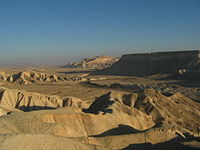
Another leading industry is tourism, which benefits from the plethora of important historical sites for Judaism, Christianity and Islam and from Israel's warm climate and access to water resources. Tourism in Israel includes a rich variety of historical and religious sites in the Holy Land, as well as modern beach resorts, archaeological tourism, heritage tourism, and ecotourism.
As Israel has liberalized its economy and reduced taxes and spending, the gap between the rich and poor has grown. As of 2005, 20.5 percent of Israeli families (and 34 percent of Israeli children) are living below the poverty line, though around 40 percent of those are lifted above the poverty line through transfer payments.
Israel's nominal GDP per capita, in 2005, was $19,248 per person (30th in the world), and its GDP per capita at purchase power parity was 26,200 (26th in the world). Israel's overall productivity was $54,510.40, and the amount of patents granted was 74/1,000,000 people. At the end of September 2006, Israel's population was 7.1 million, of whom 2.6 million were employed during the second quarter of 2006. As of August 2006, average monthly wages per employee were 7521 Shekels or 1749 USD, whilst private consumption expenditure per capita (2006, second quarter) was 12,208 Shekels or 2,839 USD. In Israel, 7.6 percent of people were unemployed in 2007.
Exports totalled $42.86-billion in 2006. Export commodities included machinery and equipment, software, cut diamonds, agricultural products, chemicals, textiles and apparel. Export partners included US 36.5 percent, Belgium 8.7 percent, and Hong Kong 5.6 percent.. Imports totalled $47.8-billion in 2006. Import commodities included raw materials, military equipment, investment goods, rough diamonds, fuels, grain, and consumer goods. Import partners included US 13.4 percent, Belgium 10.1 percent, Germany 6.4 percent, UK 5.7 percent, Switzerland 5.5 percent, China 4.2 percent.
As Israel has liberalized its economy and reduced taxes and spending, the gap between the rich and poor has grown. As of 2005, 20.5 percent of Israeli families (and 34 percent of Israeli children) are living below the poverty line, though around 40 percent of those are lifted above the poverty line through transfer payments.
Israel's per capita GDP in 2005 (purchase power parity) was $26,200 (28th in the world), and 7.6 percent were unemployed in 2007.
Demographics
According to Israel's Central Bureau of Statistics, as December 2006, of Israel's 7.1 million people, 76% were Jews, 20% Arabs, and 4% "others".[1] Among Jews, 68% were Israeli-born, mostly second or third-generation Israelis, and the rest are foreign-born: 22% from Europe and the Americas, and 10% from Asia and Africa, including the Arab countries.[2]
Israel has two official languages: Hebrew and Arabic. Hebrew is the major and primary language of the state and is spoken by the majority of the population. Arabic is spoken by the Arab minority and by some members of the Mizrahi Jewish community. English is studied in school and is spoken by the majority of the population as a second language. Other languages spoken in Israel include Russian, Yiddish, Ladino, Romanian, Polish, French, Italian, Dutch, German, Amharic and Persian. American and European popular television shows are commonly presented. Newspapers can be found in all languages listed above as well as others.
As of 2004, 224,200 Israeli citizens lived in the West Bank in numerous Israeli settlements, (including towns such as Ma'ale Adummim and Ariel, and a handful of communities that were present long before the 1948 Arab-Israeli War and were re-established after the Six-Day War such as Hebron and Gush Etzion). Around 180,000 Israelis lived in East Jerusalem,[3] which came under Israeli control following its capture from Jordan during the Six-Day War. About 8,500 Israelis lived in settlements built in the Gaza Strip, prior to their forcible removal by the government in the summer of 2005 as part of Israel's unilateral disengagement plan.
Religion
According to the Israel Central Bureau of Statistics, 76.1% of Israelis are Jewish; 16.2% are Muslim; 2.1% are Christian; 1.6% are Druze; and 3.9% unclassified.[4]
Roughly 12% of Israeli Jews defined as haredim (ultra-orthodox religious); an additional 9% are "religious"; 35% consider themselves "traditionalists" (not strictly adhering to Jewish Halakha); and 43% are "secular" (termed "hiloni"). Among the seculars, 53% believe in God. However, 78% of all Israelis participate in a Passover seder.[5] Israelis tend not to align themselves with a movement of Judaism (such as Reform Judaism or Conservative Judaism) but instead tend to define their religious affiliation by degree of their religious practice.
Among Arab Israelis, 82.6% were Muslim, 8.8% were Christian and 8.4% were Druze. There is also a small community of Ahmadi Muslims in the country.[6].
There are fourteen diverse Buddhist groups presently active in Israel, catering to Israeli Jubus as well as a tiny number of Vietnamese Buddhists who came to Israel as refugees from the crisis in their homeland and were granted citizenship.[7] A small Hindu presence exists in Israel, including Vaishnavite Krishna Consciousness devotees (mainly on the Ariel settlement)[8] Brahma Kumaris, and others. There are also small numbers of Ismailis and Sikhs. The Bahá'í world centre, which includes the Universal House of Justice, is situated in Haifa and attracts pilgrimage from all over the world.[9] Apart from a few hundred staff, Bahá'ís do not live in Israel.
Culture of Israel
The culture of Israel is inseparable from long history of Judaism and Jewish history which preceded it.
Tel Aviv, Haifa, Herzliya, and Jerusalem have excellent art museums, and many towns and kibbutzim have smaller high-quality museums. The Israel Museum in Jerusalem houses the Dead Sea Scrolls along with an extensive collection of Jewish religious and folk art. The Museum of the Diaspora is located on the campus of Tel Aviv University. Israel has artist colonies in Safed, Jaffa, and Ein Hod, as well as three major repertory companies, the most famous being Habima Theater which was founded in 1917.
As regards gay rights, Israel remains the most tolerant country in the Middle East.
Literature
Israeli literature is mostly written in Hebrew and the history of Israeli literature is mostly the product of the revival of the Hebrew language as a spoken language in modern times.
Since the middle of the nineteenth century, the Hebrew language was increasingly used for speaking as well as writing modern forms of prose, poetry and drama. Every year thousands of new books are published in Hebrew and most of them are original to the Hebrew language.
Shmuel Yosef Agnon won the Nobel Prize in literature in 1966.
Music
Israeli music is diverse and combines elements of both western and eastern music. It tends toward eclecticism and contains a wide variety of influences from today's Jewish diaspora. It also makes use of modern cultural importation. Hassidic songs, Asian and Arab pop, especially Yemenite singers, hip hop and heavy metal are all part of the musical scene.
Israel's canonical folk songs often deal with Zionist hopes and dreams and glorify the life of idealistic Jewish youth who intend on building a home and defending their homeland. These are usually known as שירי ארץ ישראל ("Songs of the land of Israel").
Israel is well-known for its famous classical orchestras and the Israeli Philharmonic Orchestra under the management of Zubin Mehta has a worldwide reputation. Dudu Fisher, Itzhak Perlman and Pinchas Zukerman are some of the more renowned classical musicians from Israel.
Music styles popular in Israel include pop, rock, heavy metal, hip hop and rap, trance (especially Goa trance and psychedelic trance), Oriental Mizrahi music and ethnic music of various sorts.
Israel has won the Eurovision Song Contest three times (1978, 1979, 1998).
Education
Israel has the highest school life expectancy in the Greater Middle East and Western Asia, and is tied with South Korea for highest school life expectancy in the entire Asian continent. It is ranked 22 out of 111 nations.[10] Israel also has the highest literacy rate in the Middle East according to the UN.[11]
The education system in Israel, up to secondary education level, consists of three tiers: the primary education (grades 1-6), followed by a middle school (grades 7-9), then high school (grades 10-12). Compulsory education is from grades 1 to 9. The secondary education mostly consists of preparation for the Israeli matriculation exams (bagrut). The exams consist of a multitude of subjects, some of them mandatory (Hebrew language, English language, mathematics, Bible studies, civics and literature), and some optional (e.g. Chemistry, Music, French). In 2003, 56.4% of Israeli grade 12 students received a matriculation certificate: 57.4% in the Hebrew sector and 50.7% in the Arab sector. [1]
Any Israeli with a full matriculation certificate can proceed to higher education, as in any country. Institutions generally require a certain grade average, as well as a good grade in the psychometric exam (similar to the American SAT). As all universities (and some colleges) are subsidized by the state, students pay only a small part of the actual cost as tuition.
Israel has eight universities and several dozen colleges. According to Webometrics (2006), of the top ten universities in the Middle East, seven out of ten are in Israel, including the top four.[12] However, as of January 2007, Webometrics ranks Israeli (and Turkish) schools among European universities, boasting four in its top 100. The Hebrew University of Jerusalem is the only university in the Middle East ranked in the Webometrics top-200 in the world. Israel is the only country in the Middle East (and one of only two in Asia, the other being Japan) that is home to a university listed in SJTU's Top 100 Academic Ranking of World Universities (Hebrew University, #60). [2] [3].
Sports
Sports in Israel, as in other countries, are an important part of the national culture. The Israeli sporting culture is much like that of European countries. Israeli athletics go back as far as before the establishment of the state of Israel. While football (soccer) and basketball are considered the most popular sports in Israel, the nation has attained achievements in other sports, such as American Football, handball and athletics. Israelis are also involved in hockey, rugby, chess, and, as exemplified by Israeli born Sagi Kalev, bodybuilding.
To date, Israel has won six Olympic medals.
Annotated list of Israeli media sources
|
General references to the Israeli media
English-language periodicals
Hebrew-language periodicals
|
Hebrew-language periodicals (continued)
German-language periodicals:
French-language periodicals:
Israeli broadcast media
Notable Internet sources
Related non-Israeli media
|
See also
|
|
|
References and footnotes
- ↑ Central Bureau of Statistics, Government of Israel. Population, by religion and population group. Retrieved 2006-12-28.
- ↑ Central Bureau of Statistics, Government of Israel. Jews and others, by origin, continent of birth and period of immigration. Retrieved 2006-04-08.
- ↑ Settlements information, Foundation for Middle East Peace. East Jerusalem Population and Area, 2000-2002. Retrieved 2006-04-08.
- ↑ Israel Central Bureau of Statistics, Government of Israel. Population, by religion and population group. Retrieved 2007-02-26.
- ↑ Religion in Israel: A Consensus for Jewish Tradition by Daniel J. Elazar (JCPA).
- ↑ Ahmadis in Israel (1999-06-05).
- ↑ BuddhaNet Middle East Directory. BuddhaNet. Retrieved 2006-11-24.
- ↑ Srila Danurdhara Swami's Waves of Devotion. Srila Danurdhara Swami. Retrieved 2007-03-24.
- ↑ http://info.bahai.org/article-1-6-0-5.html
- ↑ NationMaster - Statistics > School life expectancy
- ↑ United Nations Development Programme Report 2005
- ↑ http://www.webometrics.info/top100_continent.asp?cont=meast
External links
Template:Israel portal
- Travel guide to Israel from Wikitravel
 Wikimedia Atlas of Israel, holding maps related to Israel.
Wikimedia Atlas of Israel, holding maps related to Israel.
General information
- The Jewish History Resource Center Project of the Dinur Center for Research in Jewish History, The Hebrew University of Jerusalem
- BBC News Country Profile - Israel and Palestinian Territories
- Israel (Jewish Virtual Library)
- CIA World Factbook - Israel
- Encyclopaedia Britannica, Israel - Country Page
- US State Department - Israel includes Background Notes, Country Study and major reports
- Israel - Moshav a sample of an Israeli Moshav.
- Columbia University Libraries - Israel directory category of the WWW-VL
- Israel Lexicon definitions, events and terms related to Israel, Israel Profile (Ynet News)
- Israel21c: A focus beyond the conflict
- Hutchinson Country Facts: Israel
- Israel information at middle-east-info.org
|
Government |
Legislation and the legal system
|
|
History
|
Economy, science, and technology |
Society
- Israel Women's Network
- Gay Middle East - Israel section
- National Council of the Child Israel
- Freedom of Religion in Israeli Society and Politics by Prof. Shimon Shetreet, former minister of Religious Affairs.
- Neve Shalom/Wahat al-Salam the Oasis of Peace, an experimental Arab-Jewish cooperative village.
- Zinonist Youth Movement (Bne Akiwa)
- Israel Movement for Progressive Judaism, Reform Judaism in Israel
Credits
New World Encyclopedia writers and editors rewrote and completed the Wikipedia article in accordance with New World Encyclopedia standards. This article abides by terms of the Creative Commons CC-by-sa 3.0 License (CC-by-sa), which may be used and disseminated with proper attribution. Credit is due under the terms of this license that can reference both the New World Encyclopedia contributors and the selfless volunteer contributors of the Wikimedia Foundation. To cite this article click here for a list of acceptable citing formats.The history of earlier contributions by wikipedians is accessible to researchers here:
The history of this article since it was imported to New World Encyclopedia:
Note: Some restrictions may apply to use of individual images which are separately licensed.
